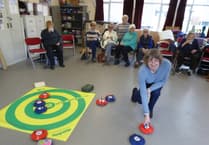The printing of the book was largely funded by 121 subscribers, both local and UK wide.
Penally History Group is grateful to Marc Jennings, Design Consultant and Tredeml Print, Tenby, for their help and assistance.
Copies of the book, priced at £15 and £2 postage can be obtained from David Glennerster on 01834 849041 or Judy Williams on 01834 844467 (mobile: 07790463417) and at: [email protected]
Architectural historian, and member of St David’s Diocesan Advisory Committee Rob Scourfield has reviewed the book as follows:
Pembrokeshire is well blessed with good medieval churches, all too few with good guidebooks let alone a whole book dedicated to its history. Penally has one of the most rewarding of the South Pembrokeshire churches, so it is fortunate then that the Penally History Group has produced St Nicholas and St Teilo – its History from Celtic Times to the Present Day.
The picturesque quality of the village rather belies its important and early origins as an Early Christian settlement, within a wider area strongly influenced by early Christianity. Here St Teilo was born (around 500 A.D.), presumed cousin of David, founder of several churches and co-founder of Llandaff Cathedral. The historical facts surrounding all this are thinly scattered and peppered with conjecture, but the gaps are slowly being filled by historians and archaeologists.
In a place so rich in early history, the authors place the parish church in its broad context, looking at the early church site at Trefloyne, the fine carved crosses and then the construction of the new church during the Norman period, when the area was re-populated and highly favoured for its fertile land and sea trade – centred on the wealthy defended port of Tenby.
The history and architecture of the present church is considered in detail in a historical context, considering the original uses of the various parts of the church (the church porch for example being an important meeting place in medieval society) and how the church and vicar was funded. Like most churches, that at Penally was restored in the Victorian period, much against the wishes of the Cambrian Archaeological Association, who advised against exposing the church to the ‘freaks’ of an inexperienced architect. They were also furious that people from Tenby has recommended that the church be coated in whitewash inside and out. Instead, the church was competently restored in 1851 by a London architect, David Brandon. The loss of the medieval wall paintings during the work is much to be regretted – ironically, whitewashing would have preserved them better than Victorian plaster. Over-enthusiastic stoking of the church boiler in January 1892 however nearly obliterated everything, were it not for the fortunate presence of the Connaught Rangers nearby, and the fire brigade at Tenby.
The book comes towards an end with a look at the more notable characters of Victorian residents (Penally being an obvious draw for well-heeled folk) as well as later residents including the actor Kenneth Griffith, brought up in the village by his grandparents. Finally, the book outlines the most recent changes in the pastoral group of churches, as the Diocese addresses the general issues of dwindling congregations and finances. As the book was being put to press, a final – and rather poignant -section notes the leaving service of the incumbent, held on the village green due to the Covid lockdown – events in themselves a key chapter in the long history of a much-loved church. Having shrugged off fire, whitewash and architectural freakery, it is much to be hoped that the church will continue to flourish and serve its community.
The book is set out in bit sized chapters and illustrated to an exemplary standard, the pace appropriately set by the splendid painting of the church on the front cover by local artist Marcia Sivell.




